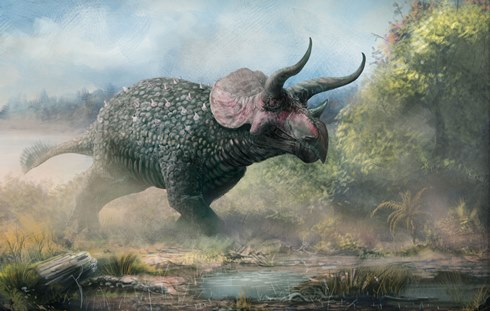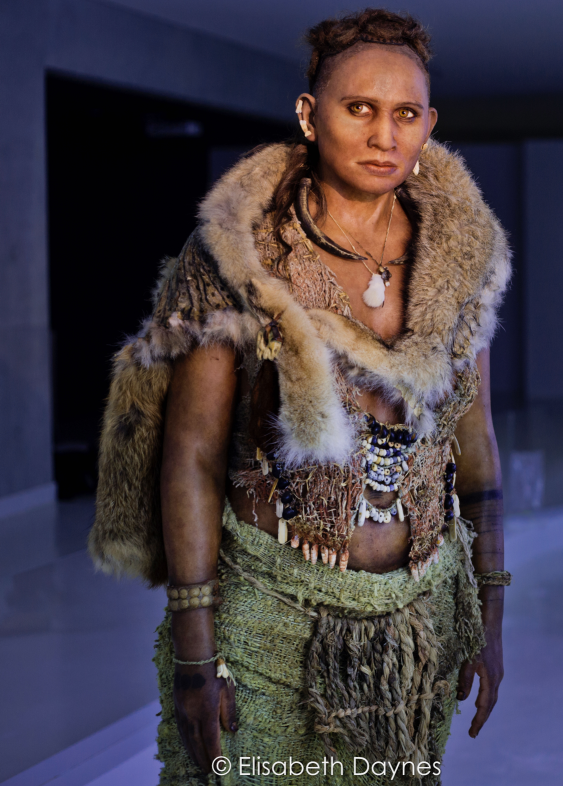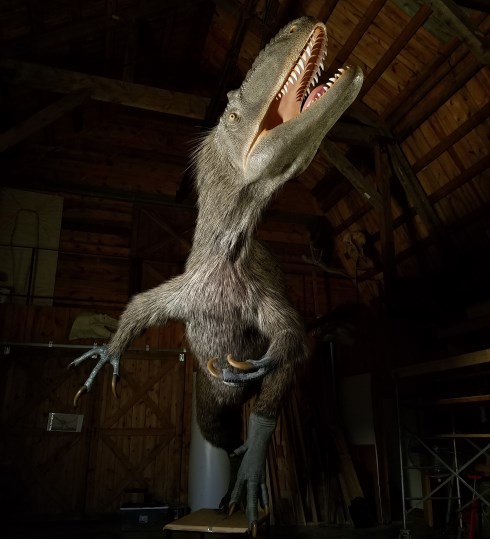From Evidence to Art

Image: Sarcosaurus by Mark Witton
Palaeoart is the term given to the striking and often controversial depictions of ancient creatures and ecosystems. We spoke to six palaeoartists about how they reconstruct ancient scenes and what a career as a palaeoartist is like
- Mark Witton is a freelance artist and author specialising in pterosaurs, and holds an honorary position at the University of Portsmouth. His book outlining the science behind palaeoart will be published later this year:
"I’m a palaeontologist by training and sort of fell into professional palaeoart. I’ve always drawn prehistoric animals as a hobby and when studying for my PhD, I started producing palaeoart for my colleague’s research PR. I still do peer-reviewed research and am probably one of the more vocal individuals in the current palaeoart crop, regularly writing about palaeoart theory, methods and culture for my blog, online magazines and journals.
I’m self-trained and work entirely digitally. It’s an ideal medium for palaeoart, as it’s much easier to update images with new data and you can easily correct mistakes.
"Few sciences have a related artform as PR-friendly as palaeontology. It’s a great way to get the general public interested in prehistoric life, and from there, into science generally. It’s also a terrific way to convert information in technical papers to a format that everyone can understand, and translates across barriers of language and age.
Another important function of palaeoart is as an illustrated history of palaeontological science. It’s easy to look at the history of palaeoart with a cynical, dismissive edge because the science it’s based on is now consigned to history. However, what we’re looking at is a visualisation of evolving palaeontological understanding. Few other sciences can boast such a visually splendid record of their history.
Palaeoart is increasingly science-led, and there are vanishingly few parts of reconstructions that are entirely imagined or speculated. Even colour – that bastion of uncertainty that artists and scientists have traditionally conceded is beyond our knowledge – is now knowable, to some degree, with ever more sophisticated techniques of interpreting fossilised pigment cells and their relationships to animal colouration.
We do not always have answers to the questions about appearance, however. There are a couple of responses to these data gaps: take them as licence for speculation or go conservative, taking the closest hint of an answer, to keep the work grounded. I think there’s room for both approaches, as well as admitting that we don't know enough about some animals to restore them properly.
Some of my favourite images are old-school palaeoart by artists such as Charles Knight and Zdeněk Burian. They excelled at evoking scale, atmosphere and mood, and I think this is sometimes lost in modern palaeoart. They weren’t afraid of hiding their animals in shadow, of surrendering an intricate animal colour scheme to the hues of a dramatic lighting setup.
Paleoartists must invest time in the research side of their work. As a science-led discipline, palaeoart is judged by the credibility of artwork as well as artistic execution. Research is also the best way to bring originality to your work – find your own inspiration in the books, papers and specimens that haven’t been pored over by the rest of us.
Palaeoart is not a career you can do half-heartedly. The palaeoart community is very friendly and welcoming, but it’s also crowded, so there’s a lot of competition for work. Paying gigs are scarce and often underpaid, especially at early career stages. There are probably just a handful of people working as full-time palaeoartists around the world – the rest support their work through other means, be that other freelance artistry or part-time careers in other professions."
- Elisabeth Daynès is a palaeoartist and sculptor who creates minutely detailed reconstructions of hominids, early man and historical figures. Her work is exhibited in museums around the world.
 Neanderthal, by Elisabeth Daynès. (Click image to enlarge.)
Neanderthal, by Elisabeth Daynès. (Click image to enlarge.)
"The reconstruction methodology is always the same. There is a meeting between the artist and the scientists. From the fossil evidence and according to the same principles of a forensic investigation, I set up an identity card for the subject: fossil group, dating, age at death, probable sex, diseases, deficiencies, dietary pattern, associated fauna, climate, living conditions, environment, culture and so on. All this data is collected during long discussions with experts, anthropologists, anatomists, palaeopathologists and palaeogeneticists, and will guide decisions at every step of the reconstruction process.
When reconstructing sapiens, I work with a forensic expert at the Paris Institute of Criminology who uses computer-assisted technology of facial reconstruction. The reconstitution begins with the bones, the preserved parts of the skull, the teeth, the pelvis, the limbs. The skull is the most important piece – then the layers of soft tissues, muscles and deep dermis, where thickness values are provided by the forensic expert.
My goal is to show real people and real individuals who lived in prehistoric times and who are not mere prejudiced schemas and discriminatory stereotypes. This work of individualisation is above all a work on faces, expressions and looks, where the starting point is the skull.
Precision and detail are essential to restore the dignity of the individuals, to arouse fragility and empathy, but also to be sensitive to the lost variety of the human family.
I want to create emotion through an extraordinary face to face. It is emotion that can overcome prejudices, whatever they are, and only an extreme attention to detail allows this. Neanderthal, my favourite, is no longer a discriminated brutal stereotype.
My work is at the border of art and science, and nothing would have been possible without privileged exchanges, meetings and collaboration with the international scientific community.
I also work on a contemporary art project called ‘the truth of faces’. In my works, I reflect and explore a world of hyper-technology and virtual reality, and a time marked by man’s obsessive quest for physical perfection and eternal youth. Boundaries between the real and the virtual, and between the artificial and the natural, are blurred. What will it mean to be human in 20 centuries?"
- Emily Willoughby is a freelance illustrator who specialises primarily in feathered dinosaurs. She is also completing a PhD in behavourial genetics.
"Before the invention of photography, artwork was the only visual method available to bring the natural world to the public. Today, palaeontology is unique among the natural sciences in that there is no other method to capture the reality of its subjects. Like the subjects we study, the methods of palaeontological reconstruction are old: we must paint, sculpt and draw to bring these animals to life.
My favourite type of work is illustrating newly described genera or behaviours for researchers, especially if it’s a new taxon with some unique feature. I also do jobs for museums, and contribute to books about dinosaurs, birds and illustration. I have also done projects for magazines and television segments, and occasionally more unusual work such as tattoo design, band art and even a children’s game.
I’m generally happy to illustrate anything with feathers, including modern birds, but my heart lives in Dromaeosauridae – Deinonychus, Velociraptor and their relatives.
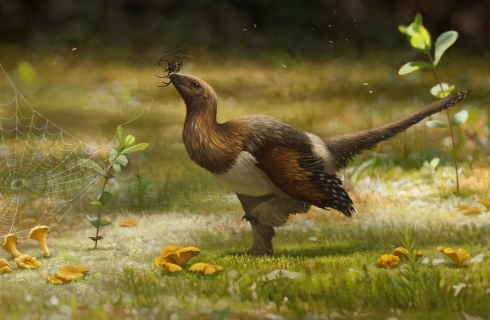 The Silky Serikornis by Emily Willoughby. Fossils of this genus of small, feathered dinosaur were discovered in modern day China and the hind-limbs are very similar to the 'silky' breed of domestic chicken. (Click image to enlarge.)
The Silky Serikornis by Emily Willoughby. Fossils of this genus of small, feathered dinosaur were discovered in modern day China and the hind-limbs are very similar to the 'silky' breed of domestic chicken. (Click image to enlarge.) I got into professional palaeoart almost by accident while completing my undergraduate degree in biology. I was contacted by Scholastic and asked for one of my dinosaur drawings for a book. That experience motivated me to seek more paying work and to hone my skills to exhaustion while completing my degree.
Science writers and natural illustrators have a unique responsibility because these renditions are often what shape the public’s perceptions of what these animals were actually like. We are, in a sense, bringing the bones back to life, but we must do so with care and respect. Through art, the public can come to know these dinosaurs as they were – not as movie monsters or mysterious creatures, but as real animals, full of beauty and life.
Deinonychus, the North American wolf-sized dromaeosaur, was first described by John Ostrom in the 1960s and is largely responsible for the deepening understanding that dinosaurs were active, complex animals rather than tail-dragging behemoths. As far as I’m concerned, Deinonychus might well be the most beautiful animal that ever lived. Its proportions were built not for speed but for power, and it may have occupied a similar niche to today’s big cats. I never get tired of drawing dromaeosaurs and Deinonychus has always been my favourite.
If you are considering a career in palaeoart, concentrate on achieving either great breadth or great depth in your work. I would gently caution against pursuing a career in palaeoart exclusively, since the demand for such work is relatively low and difficult to sustain. However, it can easily be a lucrative and enjoyable part of a broader illustration or wildlife artwork career."
- Gabriel Ugueto is a freelance scientific illustrator and palaeoartist specialising in illustrations of tetrapods.
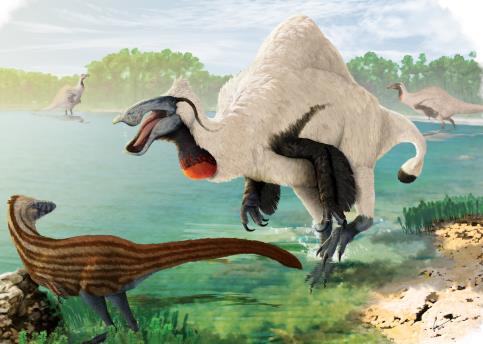 Deinocheirus by Gabriel Ugueto. (Click image to enlarge.)
Deinocheirus by Gabriel Ugueto. (Click image to enlarge.)
"I studied graphic design and illustration, but I grew up loving reptiles and amphibians, and for a long time I worked as a herpetologist researcher and authored numerous papers, including the descriptions of several new species of neotropical lizards.
My work reflects the latest scientific hypotheses about both the external appearance and the behaviour an animal could have had. In the absence of known details, I use what is known about the environment the animal lived in along with what we know about modern-day analogues to add details that most likely represent what the animal appeared and how it behaved.
Palaeoart helps people understand each new fossil discovery, while making connections to Earth’s past life forms and environments. It is vital for an illustrator to accurately depict an extinct animal. Otherwise, the public is misled.
Bones can tell us more than people think about the external appearance of an animal. Ideally, I prefer to examine the fossils in person. If this is not possible, I accumulate as much information as I can by examining photos, reading descriptions and talking to palaeontologists who specialise in that taxon. Unfortunately, most of the time fossils are incomplete or severely damaged, which is one of the biggest challenges of my work. To get around the myriad problems related to these challenges, I can model missing or damaged bones by comparing them to related species from which samples are available.
For me, it’s all about the Mesozoic Era, which includes the Triassic, Jurassic and Cretaceous. Particularly, the Triassic is fun and intriguing to me because so many truly bizarre-looking taxa appeared during that period.
To be a palaeoartist, first and foremost you have to be a well-rounded illustrator both in traditional and digital media; you have to be a good animal illustrator. It is important to be very familiar with the anatomy of extant animals and be able to read a lot of scientific papers and keep up with current research. Be prepared to read a lot – you must be a lifetime learner."
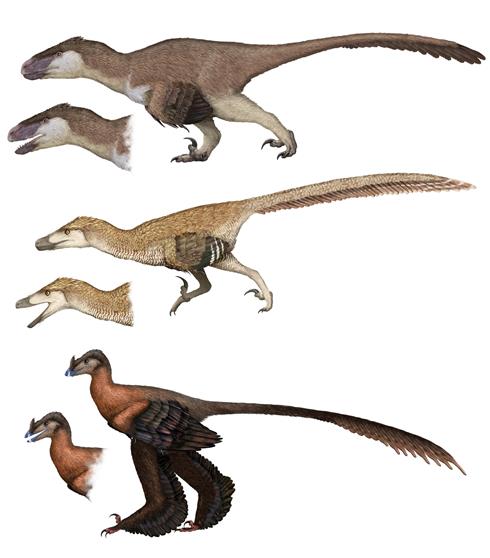 Studies of Utahraptor, Velociraptor and Zhongjianosaurus by Gabriel Ugeuto. (Click image to enlarge.)
Studies of Utahraptor, Velociraptor and Zhongjianosaurus by Gabriel Ugeuto. (Click image to enlarge.)- Gary Staab has been a freelance sculptor since 1996, having worked at the Denver Museum of Nature and Science for seven years. He has been doing palaeoart since he was 19.
"I often say I specialise in being a generalist. I get to work on an extraordinary diversity of subjects, from the first invertebrates through early reptiles, primitive mammals, dinosaurs and hominids. All these forms complement each other: even though they might seem unrelated, there are still shapes and patterns that are repeated from organism to organism.
I formulated a dual degree in biology and art at Hastings College, which also included internships at the Smithsonian Institution and the British Museum of Natural History. My clients are primarily natural history museums, but I also create some work for zoos, nature centres and documentaries.
Since we primates have such a poor ability to conceptualise large spans of time, art is one of the only ways we can see past worlds with any clarity.
Blending realism, accuracy and drama is one of the greatest challenges. If the composition or design of the sculpture or image does not elicit a reaction, that may be a sign that it should be changed or executed in a different way. It needs to work on both levels of science and art.
If I have done my job correctly, you will only see the animal for what it is and not the mark of the artist who created it. With my sculpture, I want my work to disappear. It is the animal that should be front and centre.
When there are gaps of knowledge, we look to the next best anatomical proxy, living or extinct, to fill in the missing bits. I have done a lot of dissection work to back up the soft tissue reconstructions that I have done.
For me, the most interesting palaeo subjects are the animals that have not been fleshed out before. If you are lucky enough to work on a new species, you will be creating the first look of that animal for people to see."
- Jenn Hall works at the Carter County Museum in Ekalaka, Montana, and runs her own freelance visual didactics business, Hell Creek Studio.
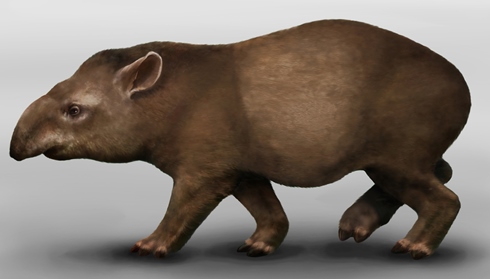 An extinct species of tapir by Jenn Hall
An extinct species of tapir by Jenn Hall"I majored in printmaking and ended up getting a minor in geology, which is how I got into palaeoart.
Working closely with scientists and curators is essential to creating an accurate and believable image, and requires an iterative approach in which the image changes and has to remain versatile during draft stages. Especially when there are multiple co-authors or collaborators on a project, the back-and-forth can be quite extensive.
When encountering knowledge gaps, the collaboration has to continue to ensure that artistic decisions are believable. It’s important not to run away with an idea because it looks cool or fierce, but to really consider why and how an animal would have appeared, which can be determined by considering ecological factors or bracket species.
That isn’t to say that purely artistic decisions can’t or shouldn’t be made – on the contrary, the most compelling and striking images are those by artists who have a very distinct style with dynamic compositions and beautiful considerations of light and atmosphere.
My projects include anything from scientific illustration to graphic design to taxidermy, typically for palaeontologists/geologists and museums. I don’t specialise in any particular species or organism, but due to my background and work at the Carter County Museum (Montana’s first dinosaur museum), I end up doing a lot of dinosaur-themed work.
I’m a sucker for Cambrian fauna. I find those wild, alien creatures captivating and enjoy visually imagining interactions between organisms and the individual events that changed DNA and pushed evolution forward. That said, I love doing fieldwork in Hell Creek and coming across Cretaceous fossils. We have the KT boundary here in Montana [the band of sediment dated to 65 million years ago, when dinosaurs died out], and when picturing individual events that’s a biggie.
Palaeoart is full of artists with different styles and specialisations, so there are a lot of inroads for those who are passionate. Being versatile and picking up skills that complement your art can help develop your career, as well as distinguish you from others in the field.
Most palaeoartists have a related career that supports their work, and makes them more marketable, whether in research, education or museum work. Also, get good at collaborating: working with and for others to communicate their message is what the job is about."
 Pterosaurs by Jenn Hall
Pterosaurs by Jenn HallThanks to all our contributors: Mark Witton, Elisabeth Daynès, Emily Willoughby, Gabriel Ugueto, Gary Staab and Jenn Hall


